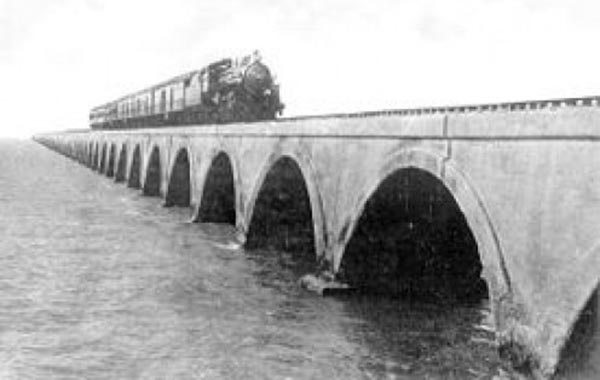In 1912, the final extension of the Florida East Coast Railway was completed. Henry Flagler’s dream of a Jacksonville to Key West railroad had come true.
Henry Flagler was best known for being a co-founder of Standard Oil. Along with John D. Rockefeller, they created a corporation worth millions of dollars. In 1885, Flagler took a trip to Jacksonville, Florida that would change his focus. He began to set his sights on the hotel and railroad business; a decision that would make Florida a destination of choice.
From Oil Magnate to Railway Builder
Henry Flagler and his wife Ida Alice traveled to Jacksonville, Florida for their honeymoon. During this trip, they went to St. Augustine and the city intrigued Flagler. In 1885 he decided to build a luxury hotel there which would attract the country’s elite. The hotel, the Ponce de Leon, was a success. The trip from Jacksonville to St. Augustine required travel down the St. Johns River. Flagler purchased the Jacksonville, St. Augustine and Halifax Railroad and built a bridge over the river thus creating a more efficient way to travel between the two cities. This was the beginning of what would eventually become the Florida East Coast Railway.
By the spring of 1889, Flagler had extended his railroad south to Daytona. He continued to build hotels along the way such as the Ormond Beach Hotel. After an 1892 trip to Palm Beach, Flagler decided to extend his railroad south from Daytona, and by 1894 had reached West Palm Beach. Here he built the Royal Poinciana Hotel and the Breakers Hotel. By 1895 he had changed the name of the railroad to the Florida East Coast Railway and by April of 1896 his railroad had reached Fort Dallas. Fort Dallas was the earlier name of Miami, and Flagler’s railroad made it a place worth visiting. He built a three hundred fifty room hotel called the Royal Palm on Biscayne Bay. There was now a string of luxury hotels that ran from Jacksonville to Miami.
Flagler’s Folly
The Spanish American War ended in 1898 and Cuba won its independence from Spain. To Flagler, this opened up a new entrepreneurial avenue. With an independent Cuba, would come possibilities for trade and tourism. Key West, a town of twenty thousand people, was only ninety miles from Cuba. A railway extension from Miami to Key West would allow travelers from anywhere in Florida to easily make their way to Key West and then to Cuba. Building large docks in Key West to bring in trade from Cuba and the Panama Canal would also go hand in hand with the railway extension.
When word spread about his plan, it received the nickname “Flagler’s Folly”. A railroad through the Florida Keys was thought to be nearly impossible due to the many spaces of open water and the harsh terrain. Flagler would not be deterred and in 1905, construction of what was to be called the Overseas Railway began.
The Eighth Wonder of the World
On January 21, 1912, the Key West Extension was complete and open for travel. Flagler left his home in West Palm Beach and traveled the two hundred twenty miles to Key West on his railroad. When he arrived on January 22, all of Key West was there to great him. The eighty-two year old had finally accomplished his dream.
The almost seven year task to reach this point had not been an easy one. There were laborers to be housed and cared for, hurricanes caused havoc, and bridges had to be built over open water. The longest of these bridges was the Seven Mile Bridge in Marathon. People began to call the Overseas Railroad the “Eighth Wonder of the World”.
The Florida East Coast Railway Today
Today, the Florida East Coast Railway operates three hundred fifty one miles of track from Jacksonville to Miami. It runs along most of the same tracks as Flagler’s original. It is now a freight service train only; passenger service was stopped in 1968.
The Overseas Railroad no longer operates to Key West. It was destroyed in the Labor Day Hurricane of 1935. The Overseas Highway, which now connects Key West with the mainland, runs along much of the original rail track. Henry Flagler’s dream of connecting all of east Florida became a reality and serves as an example of imagination, ingenuity, and determination.
Sources:
- Standiford, Les, Last Train to Paradise, New York, Crown Publishers, 2002.
- Henry Morgan Flagler Museum
- The Florida East Coast Railway, Over 100 Years of Service in the Sunshine State








